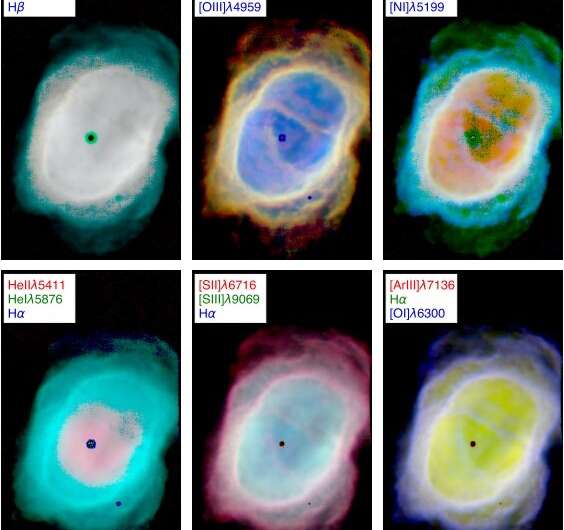December 16, 2019 report
Planetary nebula NGC 3132 investigated with MUSE

Using the Multi Unit Spectroscopic Explorer (MUSE) instrument, European astronomers have taken a closer look at the planetary nebula NGC 3132. MUSE observations have delivered crucial data regarding the nebula's physical and chemical properties. The new study is detailed in a paper published December 5 on arXiv.org.
Planetary nebulae (PNe) are expanding shells of gas and dust that have been ejected from a star during the process of its evolution from a main sequence star into a red giant or white dwarf. They are relatively rare, but are important for astronomers studying the chemical evolution of stars and galaxies.
Although NGC 3132 has been a subject of several studies, many questions about its nature remain unanswered. What is known is that the central object of this PN is a wide visual binary most likely consisting of an ionizing star with an effective temperature of around 100,000 and a companion star of spectral type A0. There is a huge uncertainty about the estimated distance to NGC 3132, as some studies suggest that is located about 1,760 light years away, while others indicate distances of up to 4,042 light years.
In order to shed more light into the properties of NGC 3132, Ana Monreal-Ibero of University of La Laguna, Spain and Jeremy R. Walsh of the European Southern Observatory (ESO) in Garching, Germany, investigated this object with MUSE. It is a panoramic integral-field spectrograph on ESO's Very Large Telescope (VLT) operating in the visible wavelength range. The instrument allowed the researchers to learn more about physics and chemical composition of this PN.
"Two-dimensional spectroscopic data for the whole extent of the NGC 3132 planetary nebula have been obtained. We deliver a reduced datacube and high-quality maps on a spaxel-by-spaxel basis for the many emission lines falling within the MUSE spectral coverage over a range in surface brightness greater than 1000. Physical diagnostics derived from the emission line images, opening up a variety of scientific applications, are discussed," the astronomers wrote in the paper.
The observations uncovered the complex morphology and ionization structure of NGC 3132. In particular, two low-ionization arc-like structures have been found toward the north and south of the nebula. The newly detected features showcase extremely high extinction and helium abundance, which, according to the authors of the paper, suggests that they may be the consequence of precessing jets caused by the binary star system.
The extinction map displays the considerable structure of NGC 3132, with large areas showing values up to four times higher than the median value, especially beyond the eastern side of nebula's rim. The astronomers assume that this characteristic, demonstrating the survival of dust as an internal component of nebula, may be common for PNes.
The research found an inner high-ionization plasma at relatively high density of about 1,000 cm−3, while the low-ionization plasma was found to exhibit a structure in density with typical values of around 300 cm−3 and peaking at the rim with values at a level of 700 cm−3. Moreover, median electron temperature suggests the presence of high-density clumps in NGC 3132.
According to the paper, the estimated median helium abundance [He/H] of the studied PN was found to be approximately 0.124, with slightly higher values at the rim and outer shell. When it comes to ionic abundances of light elements, the results were found to be compatible with previous studies.
In concluding remarks, the researchers noted that wide-field integral field spectrographs like MUSE are important to advance the knowledge of planetary nebulae. "Together with the work on NGC 7009 presented by Walsh et al. (2018), the present study illustrates the enormous potential of wide field integral field spectrographs for the study of Galactic PNe," the astronomers concluded.
More information: The MUSE view of the planetary nebula NGC 3132, arXiv:1912.02847 [astro-ph.SR] arxiv.org/abs/1912.02847
© 2019 Science X Network




















